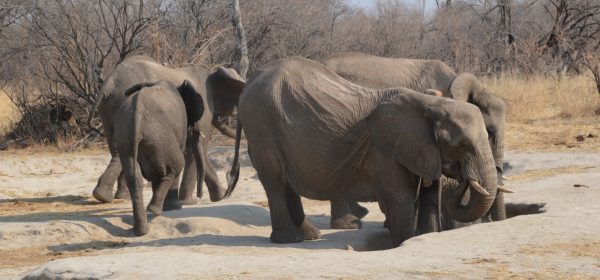SELECTED ARTICLE FROM OUR SPECIALISTS
A Road Less Travelled – Hwange National Park
Hwange National Park in Zimbabwe is one of Africa’s finest reserves and is probably Africa’s premier park for elephant.
Bordering Botswana, Hwange National Park is Zimbabwe’s largest game park with an area of 14,600km². Its sheer size means that its scenery, vegetation and game vary hugely, ranging from the semi desert scrub on the edge of the Kalahari in the south, to forests, granite hills and valleys of mopane woodlands in the north.
Despite Zimbabwe’s widely publicized differences with Western countries and the subsequent meltdown in the economy Hwange has been well maintained by a dedicated group of volunteers and the park authorities and is a very safe place to visit.
The park has an excellent road network and it is only two hours to the nearest park gate from Victoria Falls Airport making it very accessible. There are also reasonably priced charter flights into the reserve.
The “Big Five” plus cheetah and wild dog are found in the park as well as spotted and rare brown hyena. The large sable and roan antelope, are rare or absent from many African parks but surprisingly common here.
The park sees very few visitors but has a small number of excellent little safari camps. Some of the safari camps in the reserve are based in their own private wildlife concessions ensuring a high level of exclusivity for guests and protection for wildlife. These include Linkwasha and Little Makololo Camps. We would suggest that if guests have the time they should spend around 6 to 8 nights in the park split between two contrasting areas.
The success of this park is due in no small part to man’s intervention. The park is a paradise for wildlife for nine months of the year but for the three to four months of the late dry season there is very little surface water which would minimise the wildlife population. Historically, during the dry season, wildlife has migrated from Hwange to areas such as Botswana’s Okavango Delta and the Zambezi buy aciclovir tablets 400mg Valley and other areas where there is human settlement and farming on the fringes of the park. Ted Davison the first warden of the park decided that if the park was to be a success then action had to be taken to ensure wildlife remained throughout the year and did not compete with settlers for water and food. A decision was taken to dig boreholes widely dispersed throughout the reserve and powered initially by windmills. These have now been replaced by diesel and solar powered pumps creating permanent waterholes dependent on human beings for maintenance.
The result has been an explosion in the elephant population which now number around 44000 and reside permanently in the reserve. The waterholes attract huge numbers of wildlife in addition to the elephant and those close to the lodges are usually floodlit allowing guests to take some wonderful close-up photos from hides on the water’s edge.
It may be possible for guests at certain lodges such as Bomani Tented Camp or Camelthorn Lodge to join the team that maintain the pumps on the weekly pump run visiting some of the most remote areas of the park and assisting the team maintaining these vital lifelines for the wildlife.
The quality of the guiding in the park is of a very high standard and in addition to game drives, most safari camps offer night drives and guided walks in their own private concession areas.
A visit to Hwange is incredibly good value compared to other parks in Southern and East Africa, look at our Land of the Giants and Elephant Trails itineraries for safaris that visit this reserve.
Most guests visiting this reserve will combine a stay in Hwange with a few nights at Victoria Falls but it is also possible to combine a stay here with the world heritage Mana Pools reserve on the Lower Zambezi River and Matusadona National Park on the shores of Lake Kariba to create a very varied itinerary.
 Just a phone call away to start planning your holiday
Just a phone call away to start planning your holiday
01 664 464 228


